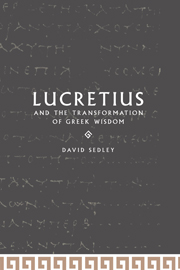Book contents
- Frontmatter
- Contents
- Preface
- Introduction
- Chapter 1 The Empedoclean opening
- Chapter 2 Two languages, two worlds
- Chapter 3 Lucretius the fundamentalist
- Chapter 4 Epicurus, On nature
- Chapter 5 Lucretius' plan and its execution
- Chapter 6 The imprint of Theophrastus
- Chapter 7 The transformation of book I
- Epilogue
- Bibliography
- Index locorum
- General index
- Index of modern scholars
Chapter 5 - Lucretius' plan and its execution
Published online by Cambridge University Press: 22 September 2009
- Frontmatter
- Contents
- Preface
- Introduction
- Chapter 1 The Empedoclean opening
- Chapter 2 Two languages, two worlds
- Chapter 3 Lucretius the fundamentalist
- Chapter 4 Epicurus, On nature
- Chapter 5 Lucretius' plan and its execution
- Chapter 6 The imprint of Theophrastus
- Chapter 7 The transformation of book I
- Epilogue
- Bibliography
- Index locorum
- General index
- Index of modern scholars
Summary
THE THESIS
In Chapter 3, I built my case for regarding Lucretius as an Epicurean fundamentalist, feeding directly on the writings of his school's founder, and uninterested in pursuing the history of philosophy beyond the zenith which Epicurus himself represented. In Chapter 4, I have put together a dossier on Epicurus' major physical treatise, On nature, seeking to understand why it was at once the most demanding and the most valued of all Epicurus' texts. Drawing on these findings, the present chapter will defend the following account of Lucretius' procedure when composing the De rerum natura.
Lucretius' sole Epicurean source, I shall argue, was Epicurus' On nature, and, of that, mainly the first fifteen of its thirty-seven books. Initially he followed its sequence of topics very closely, indeed almost mechanically. But to some extent as he proceeded, and to a greater extent during a phase of rewriting, he developed a radically revised structure for the whole. At his death, the reorganisation of DRN I–II was (so far as I can judge) complete. For books IV–VI, however, he had plans which can still to some extent be discerned from his proems, but which he did not live to put into operation.
The Lucretian material of which I am speaking is the physical exposition in the main body of all six books.
- Type
- Chapter
- Information
- Lucretius and the Transformation of Greek Wisdom , pp. 134 - 165Publisher: Cambridge University PressPrint publication year: 1998



